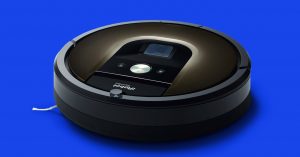The (old) Google WiFi was a series of interchangeable pucks that, when put together, created a mesh around your home. If you had a gnarly blackspot or a house that was bigger than the maximum range, you could just tack on another unit to improve speeds or reception. Modularity offered flexibility, and that was a big selling point for this and every other mesh WiFi system of its type. Now Nest WiFi has replaced it.
This time, Nest WiFi is split into two units: a dedicated router (the Router) and an access point (a Point). The Router is a featureless dome that sits by your modem and pumps WiFi around your home. The Point, meanwhile, is a mesh repeater with a speaker and Google Assistant built-in, making it do the work of both a WiFi point and a Google/ Nest Home Mini.
The Router has a range of around 2,200 square feet, with each Point adding an additional 1,600 square feet. Inside, the Router’s wireless radios are twice as powerful as Google WiFi, with far better support for multiple devices — making it easier to, say, watch Netflix on multiple devices. And it has a quad-core, 64-bit ARM CPU clocked at 1.4GHz, 1GB RAM and 4GB onboard storage. It offers support for 802.11 a/b/g/n/ac, but not the new WiFi 6 standard, which is disappointing.
WiFi 6 isn’t just a speed boost on the existing wireless technology; it also makes it easier for multiple devices to run at once. And its omission here rankles because Google’s Chris Chan told VentureBeat that it was down to cost and complexity right now. On one hand, sure, WiFi 6 won’t be ubiquitous for another couple of years, but that also means that your WiFi gear will need yet another pricey upgrade by 2021.
The original Google WiFi pucks were tidy and austere, but not unpleasant to look at. Nest WiFi is a lot softer looking, and there isn’t a straight line anywhere on its body. The vent lights also look pretty nice. The Nest is taller, so it can’t unobtrusively sit below my TV like the Google WiFi does, which is frustrating — for me.
Google prides itself on the power of its software, and its devices barely require any sort of setup at all. That should have been the case here, and it nearly was, but the system kept freezing in the last phase of setup. It took me half an hour to get it working, which, for Google, is an eternity, but I’ll blame this isolated incident on pre-release software for now.
Those new to Google’s WiFi efforts will be surprised at how quick it is to get everything working, especially if you’re normally used to fiddling with the equipment thrown in with your cable provider. Here, the only fiddly bit is to set your cable modem to modem-only mode and connect it to the Nest Router.
And, if you’re thinking about upgrading from Google WiFi, it’s possible to add Nest gear to your existing network, or vice versa. You’ll just need to factory reset all of your gear and then set up the Nest hardware first, adding each Google puck individually.
The Nest WiFi Point
Then there’s the Nest WiFi Point, which is a Google WiFi puck with a Nest Home Mini stuck on top. That’s gratingly reductive but also completely true. The pair have been redesigned to look like one seamless whole. You get a lovely white glowing light at the base of the unit, which pulls double duty as a volume indicator when playing music.
The top of the Point is a touch surface you tap the center of for play/pause, and hit either side for volume control. There are four cut-outs for microphones, and the symmetry means it’s hard to know, at first glance, where you need to tap. Thankfully, glowing lights underneath, which turn on when you approach the device, direct you where you need to tap.
Naturally, Google wants you to use its Assistant, here, and there’s little new to say about the well-worn voice service. The company hopes you’ll use your voice rather than the app to control it — for instance, to activate Bluetooth pairing mode. If I have one complaint, it’s with playing music requests; Google’s platform has a knack for picking obscure covers and remixes of songs in Spotify. And it is a Google-specific problem: Ask for the same thing on Siri and you get the proper version.
There’s little to distinguish the sound quality from the Point compared to the Home Mini I tested next to it, either. Both have the same max volume and offer clean but not very detailed audio that’s fine for background music. The one difference is that the Point is taller, with a down-firing bass speaker that, when on a table, makes the sound a little punchier. This will not, however, replace a proper speaker if you need room-filling sound in your room, even at maximum volume.
Of course, having one device that can pump WiFi around your home and act as an Assistant makes plenty of sense. I’ve had mine in my kitchen and use it specifically to play tunes over breakfast, a job it suits well.
Sadly, the Point does not have its own Ethernet ports, like the Router, and all of the Google WiFi pucks of old. Google apparently knows how many of its users actually employed those ports, and ditched them to save money. I’m sure homes in Southern California have lovely porous walls that allow all sorts of high-speed WiFi through. But, sadly, if your home is a little older or built from something other than wood and drywall, you’re going to have a problem. I’ll elaborate on performance later.
Google has pushed control of its devices from the Google WiFi app, which has been knocking around since the OnHub days, to Google Home. Pushing it to the search engine’s all-in-one home and media center does, at least, give you a one-stop shop for all your tech.
Unfortunately, it also buries a lot of the more complex things you can do with Nest WiFi behind menu after menu. The hope is that you’ll lean on voice commands more than before, like asking your Point to enter Bluetooth pairing mode, rather than delving deep into the settings.
Performance
Remember my gripes about a lack of Ethernet ports on the Point? I live in a beautiful, if crumbling, Victorian house. It’s around 2,200 square feet across two levels, plus a 300 square foot loft where my office is. That should be well within the coverage Google and Nest WiFi offered, but there’s a problem: Victorian plumbing is notoriously WiFi hostile.
There’s a dividing line between my living room, where my cable modem and router sits, and the kitchen. With two Google WiFi points, the connection was weak, even though they’re only 50 feet apart and divided by a single wall. Nest WiFi, on the other hand, handled that single wall with aplomb, giving me a great connection between the two.
My current setup uses four Google WiFi points to skirt around the problematic areas of my home. There are two points in the ground level, in the living room and kitchen, one on the first-floor landing and one in the back bedroom. In the back half of the house is a lot of plumbing, as well as the bathroom, so getting anything to the other side is problematic at best.
To get WiFi in the back of the kitchen and garden, I have a pair of Power over Ethernet plugs, which transmit data through my home’s power lines. Of course, in Google’s Ethernet-free world, the Point wasn’t strong enough to cover the three-or-so meters between the kitchen and back bedroom.
This one issue aside, there’s a marked improvement in both speed and reliability compared to the older version. For all of the complaints I may have, Google has managed to make an affordable mesh setup, which does the bulk of what it promises. It uses its tech well to hide some of its technical inadequacies, like the lack of a dedicated backhaul channel, which most won’t miss.
For a real-world stress test, I ran two 4K streams at opposite ends of the house while a 1080p set-top-box streamed live and recorded TV and YouTube streamed on my phone. After an initial stutter, the video to all devices was clear and at full-res, with no noticeable dropouts. That should be sufficient for a busy home with multiple teenagers glued to YouTube.
As for overall speed, with older Google WiFi, my speed was regularly 211 Mbps down and 20 up. With Nest Wifi, it often reports 210 Mbps down and 19 Mbps up, close enough that you can chalk the difference down to measurement issues.
The competition
On its own, the Nest Router will cost $169, and a pack with a single Point costs $269. If your coverage needs are greater, you can get a version with two Points for $349, with each additional Point costing $149.
A three-pack of eero (owned by Amazon), which has a slightly shorter range (5,000 square feet, versus 5,400), will set you back $249. There are also options to chop-and-change which eero gear you use, from the pricier eero Pro down to the wall-outlet-mounted eero Beacon. And, aside from the Beacons, each eero has Ethernet as standard.
Netgear is a big name in networking and is also one of the first to market a WiFi 6-supporting mesh system. Like its peers, the Orbi WiFi 6 system will cover homes around 5,000 square feet with just two units and promises superior networking and speed. The downside, of course, is that you’re paying a lot for the system: A two-unit setup will cost you a staggering $700.
Plume’s subscription-based WiFi gear costs $99 a year, plus an additional $297 for three SuperPod nodes. That, however, you can tweak depending on the size of your home, with each individual unit costing $99. It depends, of course, if you’re the sort of person who wants to turn WiFi into a utility, and if the promise of support and protection is worth the cost.
Wrap-up
The point of Google’s mesh WiFi system is to take away the stress of setup from those folks who have no interest in using 192.168.1.1. If you don’t have mesh WiFi yet, and you want one, then Nest WiFi is clearly a no-brainer. You should be able to set up this system and forget about it for a very long time.
And Google is a company that promises to worry about your internet on your behalf. It has an interest in keeping you connected and pushes regular updates to its software to improve reliability, speed, safety and security. Nest WiFi is faster, more reliable and comes with Assistant built-in, which is a welcome bonus if you want it.
But there are caveats, like the reduced flexibility that comes with the loss of Ethernet ports on the Point. If you have a blackspot that can only be connected with a wire, you’re going to need to use a different solution to solve the problem. And a lack of WiFi 6 could be a dealbreaker if you’re looking to buy something that’ll last you for the next five-plus years. You could also resent having to pay more for a smart speaker you may not want in your home — especially when Google’s own hardware chief said he’d warn guests to his house about them.
That shouldn’t detract from some good-looking hardware that’s speedy and reliable and enough for most folks. Especially if all you’re doing is playing games and watching videos on multiple devices, which is what most families do. I wish Google would push the envelope a little harder, rather than settling for good enough for most folks.
All products recommended by Engadget are selected by our editorial team, independent of our parent company. Some of our stories include affiliate links. If you buy something through one of these links, we may earn an affiliate commission.

Comments

74
Shares






